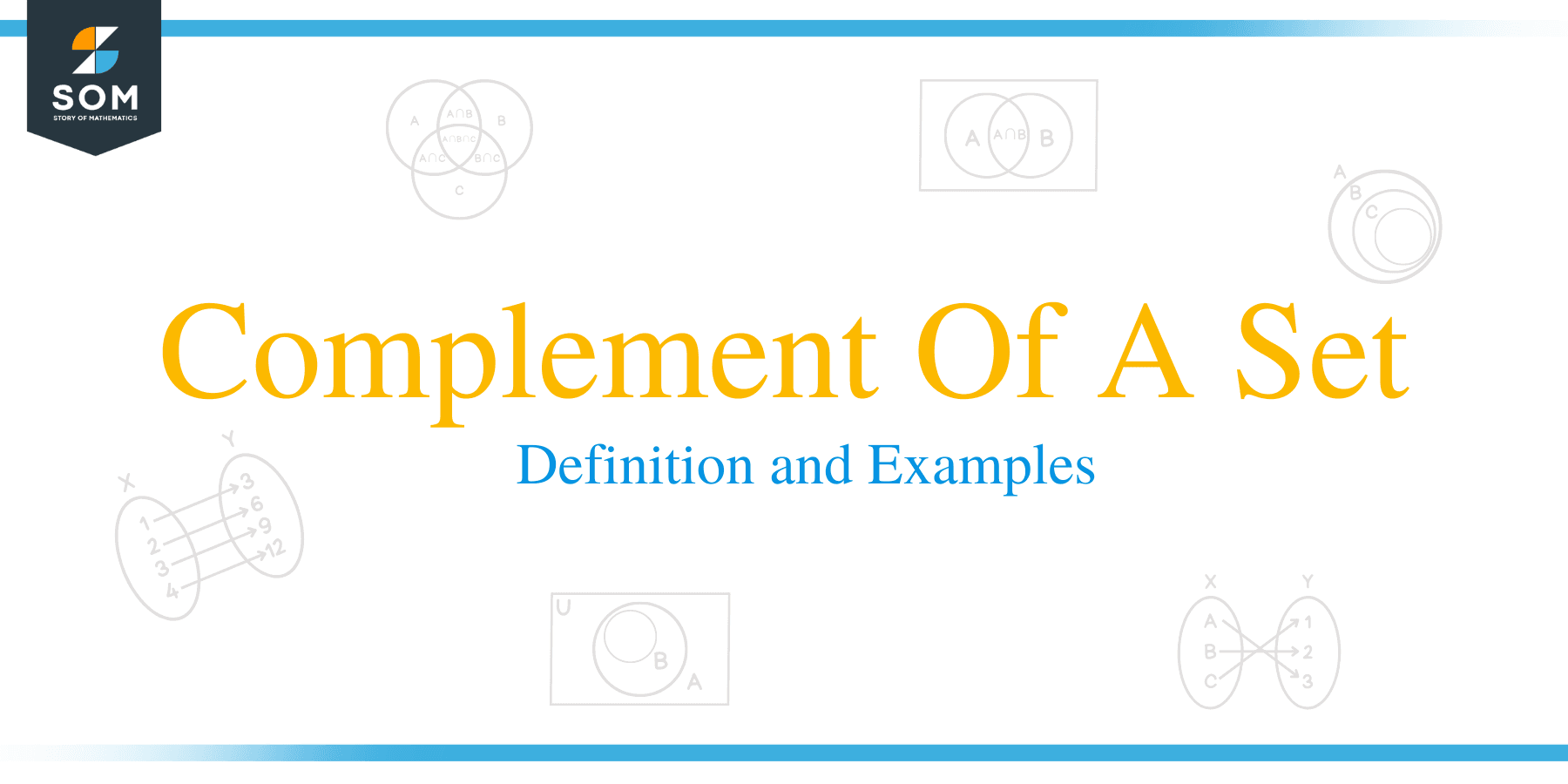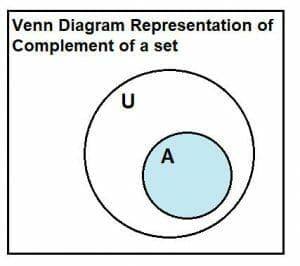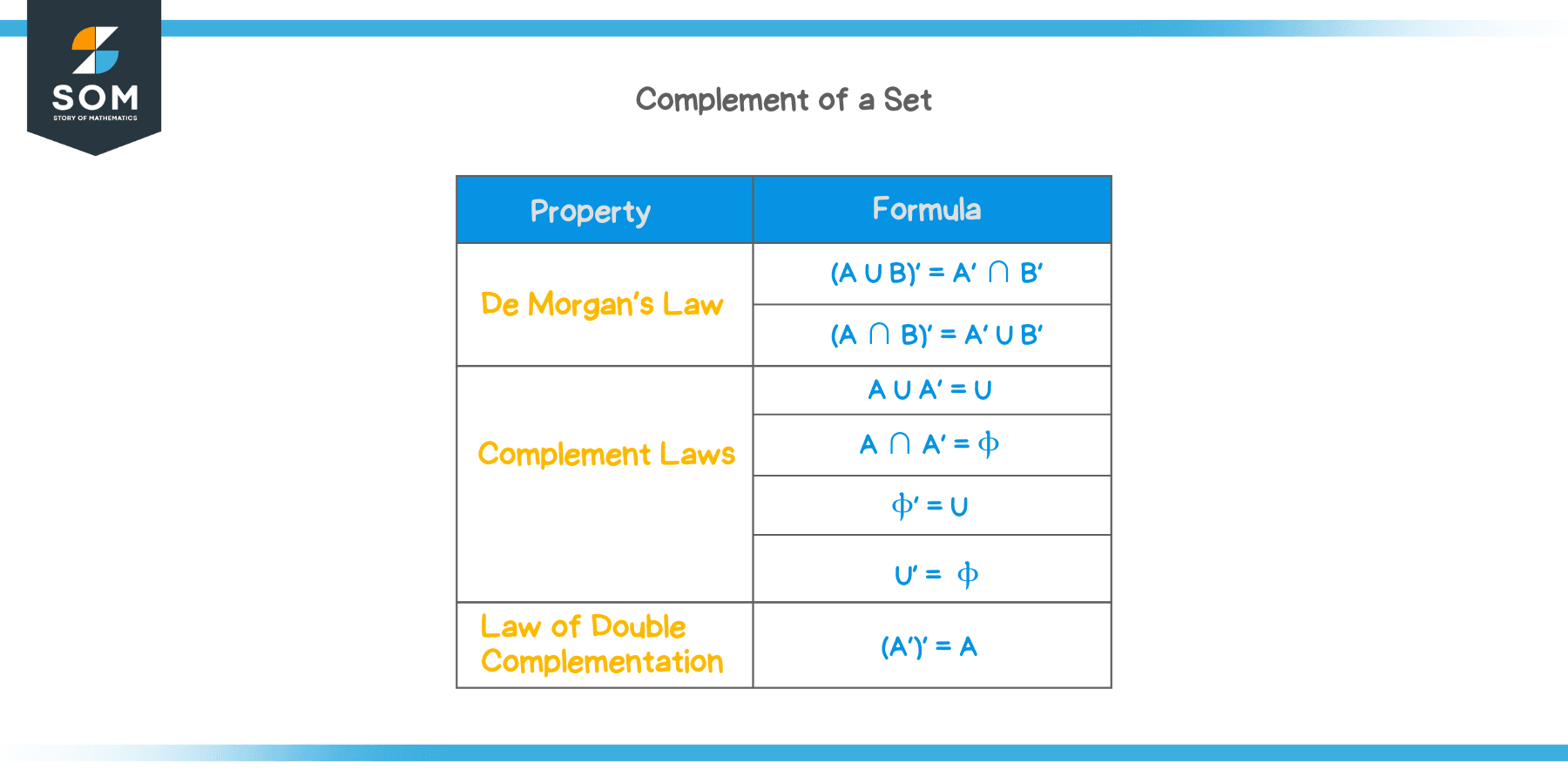- Home
- >
- Complement of a set – Definition and Examples
JUMP TO TOPIC
Complement Of A Set – Definition and Examples
 Any activity is called an operation of a set whenever two or more sets combine in some defined way to form a new set. From this, we know that we can combine sets in various ways to produce new ones. To perform any operation, we need specific tools and techniques and problem-solving skills. Apart from union and intersection, another important technique in the realm of sepsis finding the Complement of the Set.
Any activity is called an operation of a set whenever two or more sets combine in some defined way to form a new set. From this, we know that we can combine sets in various ways to produce new ones. To perform any operation, we need specific tools and techniques and problem-solving skills. Apart from union and intersection, another important technique in the realm of sepsis finding the Complement of the Set.
In this lesson, we will be talking about this new operation called the complement of a set.
The complement of a set A can be defined as the difference between the universal set and set A.
We will cover the following topics in this article:
- What is the complement of a set?
- Venn diagram representing the complement of the set.
- Properties of the complement of a set.
- The complement laws.
- Examples
- Practice problems.
Before moving forward, you may consider refreshing your knowledge on the following prerequisites:
What is the Complement of a Set?
To understand complement, we need first to understand the concept of a universal set. Before learning a new skill, developing an understanding of the basic ideas and concepts becomes a primary necessity.
We know that a set is a collection of unique objects represented using elements inside the curly brackets ‘{}’. We discussed different types: a subset, null set, superset, finite and infinite set, etc. This variety of sets represents meaningful data, for example, books in a library, addresses of different buildings, location of stars in our galaxy, etc.
As we mentioned earlier, a compliment of the set is the difference between the universal set and the set itself. We have already covered the universal set concept in our previous lessons, but to recap, a universal set is a fundamental set for which all other sets are the subsets of that set. It is denoted by U.
Now that we have conducted a quick recap of the universal set, we will move on to the next task: finding the complement of a set. The difference between two sets, A and B, contains all the elements present in set A but not in set B. It is written as A – B.
For example, set A defined as {5, 7, 9} and set B defined as {2, 4, 5, 7}. Then the difference of set A and B, written as:
A – B = {9}
Similarly, B – A would be:
B – A = {2, 4}
Now let’s solve an example to understand this concept better.
Example 1
You are given two sets, A and B, which are defined:
A = {10,19, 12, 15, 2, 3}
B = {12, 16, 14, 2, 4}
Find out:
- A – B
- B – A
And explain the difference between the two.
Solution
A – B is defined as all the elements present in A but not in B.
So set A – B is given as:
A – B = {10, 19, 15, 3}
Next up, B – A is defined as all the B’s elements but not in A.
So set B – A is given as:
B – A = {16, 4, 14}
Notation of the Complement of a Set
Understanding concepts like the difference of sets and the universal set make it easier to achieve the milestone of calculating the complement of the set. Now when we have achieved these milestones, let us combine them all and look at the mathematical representation of a complement of a set.
Suppose we have set A, a subset of set U, where set U is also known as the universal set. Then mathematically speaking, the complement of a set A is:
A’ = U – A
Here, A’ is the mathematical representation of the complement of A. U is the universal set we studied before. A’ can be defined now as the difference between the universal set and set A such that it includes all the elements or objects of the universal set which are not present in A.
Let us do an example to understand this operation better.
Example 3
Consider two sets; one is universal, and the other one is its subset. These sets are defined as:
U = {1, 12, 23, 2, 6, 7, 11, 10, 16}
A = {1, 2, 5, 7, 8, 9, 10}
Find out the complement of set A.
Solution
We know that the complement of a set is defined as:
A’ = U – A
So,
A’ = {1, 12, 23, 2, 6, 7, 11, 10, 16} – {1, 2, 5, 7, 8, 9, 10}
A’ = {12, 23, 6, 11, 16}
Hence A’ is the difference between U and A, and it implies all the elements are present in U but not in A. In our case, these elements are a set of {12, 23, 6, 11, 16}.
Venn Diagram Representation
To have a visual understanding of the complement of a set, the Venn diagram is the most suitable tool. It helps us understand the operations on sets comprehensively as they are frequently used to represent finite sets.
The region inside a Venn diagram is represented as a set, whereas the elements are represented as points inside this region. This way of representation allows us to understand the operation holistically.
Consider the data from example 2; let’s try to visualize it using Venn’s diagram. The complement of A, as given in example 2, will be:

As we can see from the figure, we have a region U such that A is a subset of U. In this case, the complement of A is represented here using the region in red. This red region represents the complement of A using the entire region of U except for A.
Properties of Complement of a Set
As we are only studying absolute complement in this lecture, so we will only discuss their properties. All properties can be divided into De Morgan’s laws and complement laws. So, let us get to it.
Before we discuss the properties in great detail, we will define two sets, A and B, which are subsets of a universal set U. We will use these sets in the following topics: 
De Morgan’s laws:
There are two variations of De Morgan’s laws,
- (A U B)’ = A’ ∩ B.’
As we can observe, the law states that the right and left sides of the equation are equal. Now, what do these left and right-hand sides of the equation depict?
The left-hand side guides us to take the union of set A and B and then take the complement of A and B’s union.
The right-hand side guides us to find the complement of A and B individually and then perform the intersection operation between each set’s complements.
- (A ∩ B)’ = A’ U B.’
In the other variation of De Morgan’s law, we switch the union and intersection symbols. This property also has the left and right sides of the equation.
On the left-hand side, we first take the intersection of two sets, A and B. We then find the complement of this intersected set. Whereas, on the right side, we first take the complement of both sets of individuals. This is a critical step; more crucial is understanding the sequence of steps and when to perform which operation.
Anyway, once you’ve found out the complement of both sets, the next step is to take the union of these complemented sets. Both these sides of the equation should turn out to be equal to satisfy the property.
Complement laws:
There are 4 variations of the Complement laws.
- A U A’ = U
The union of A with its complement must always equal the universal set.
To check whether the complement you have found out is correct or not, you can find the complement’s union with the original set; if the result of this specific operation equals the universal set, your complement calculation is correct.
This is what is stated in this property.
- A ∩ A’ = Ⲫ
The intersection of A with its complement must always equal the null set.
This property states that you will always get a null set whenever you take the intersection of a set with its complement. A null set is also known by the name “empty set.” It is intuitively sound as well. There would be no common elements between a set and its complement.
Let us do an example to understand this better.
Example 4
Prove the above property when U and A are defined as:
U = {2, 4, 6, 8}
A = {2, 4}
Solution
First, we will find the complement, and then we will proceed onwards.
The complement is given as:
A’ = U – A = {6, 8}
A ∩ A’ = {2, 4} ∩ {6, 8} = null set
As the intersection results in an empty set, the left-hand side is equal to the right-hand side.
- Ⲫ’ = U
The complement of the null set must always be equal to the universal set.
This property discusses the complement of any null or empty set. As the difference between a Universal set and an empty set will be equal to the universal set. We can write it as:
U = U – Ⲫ
- U’ = Ⲫ
The complement of a universal set must always be equal to the null set.
This property is quite easy to understand as well; subtracting a set with itself will yield a null set; we do know that for a fact. If we subtract the universal set from itself, it will result in a null set or an empty set.
Example 5
Prove that the complement of U is equal to null, where U is defined as:
U = {1, 4, 8, 9, 13}
Solution
The complement of U is defined as:
U’ = U – U = all the elements in U which are not present in U
There is no such element present in U but not in U, as they are the same set. Therefore, the left-hand side is equal to the right-hand side.
U – U = Ⲫ
Law of Double Complementation:
We discussed the different properties of a complement of a set. But we have not discovered what happens when you take the complement of a compliment. This is what the law of double complement entails, as the name suggests as well.
Whenever you take the complement of the complement of a set, you get the original set. It is, like other properties, intuitive as well.
If you subtract A with a universal set, then subtract the resultant again from the universal set, you will get the original set back.
Consider the following practice problems to strengthen the concepts of the complement of a set.
Practice Problems
- Find out the complement of A when, U = {4, 7, 8, 9, 12} and A = {4, 7, 8, 9, 12}.
- Prove the first De Morgan’s Law using U = {2, 3, 14, 15}, A = {2, 4} and B = {6, 15}.
- Can we say that A – B is equal to B – A? Give reasoning.
- Find out the complement and intersection of U = {natural numbers}, A = {even numbers}.
- Show that the complement of a null set is the universal set.
Answers:
- Null set
- Left to the reader
- No, the reasoning is left to the reader
- A’ = {odd numbers}, U ∩ A = {even numbers}
